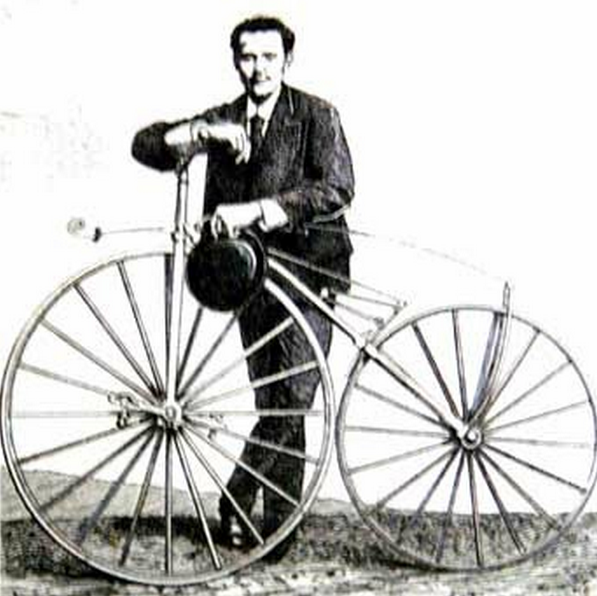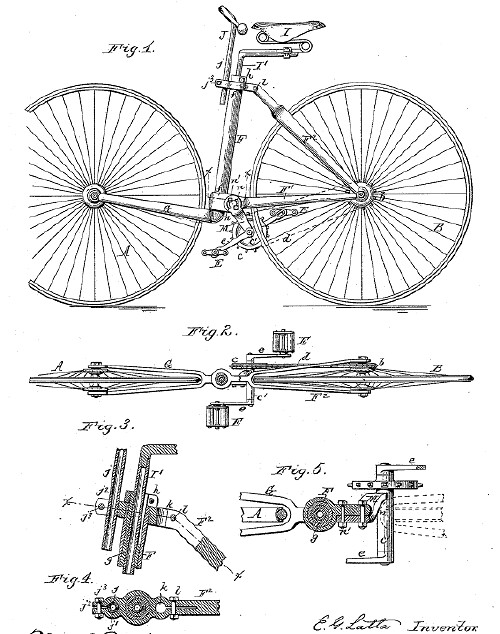While many people think that folding bikes are a more modern invention, they have been around for quite a while. Although cycling and biking to work certainly seem like they are gaining popularity nowadays, there has been a need for compact bicycle solutions for decades. More people are downsizing to smaller apartments or in houses with less storage space. This makes folding bicycles conducive. The earliest history of the folding bikes starts in the 1800s with eclectic designs, all trying to fit into a small package and still maintain the feel of a full-sized bike into a smaller package.
Folding bikes are derived from full-size bicycles, which were invented around the 1860s. Many “pre-bicycle” forms were created: with handlebars, without pedals, and so on. The bike that most resembles the one we ride today was invented in 1860 by two Fenchmen, Ernest and Pierre Michaux. This bike had pedals and handlebars. After that, the English became very active in advancing bicycle expertise and knowledge. The English are also responsible for the invention of the safety bike which has similar function to the modern day bike with larger wheels. The first United States bicycle patent that was powered by pedals was submitted by Pierre Lallement in 1866.

There have been many inventors who have tried to claim the title of inventor of the folding bike. The tricky part is that throughout history there have been historical references to bikes that are “separable” or have “break-away” parts. However, folding bikes have collapsible frames that still stay in one piece. While the true first inventor of the folding bike may not be known, there are a few competitors for the title. In the 1880s, there were a few drawing of something that resembles a folding tricycle, invented by the Pop Manufacturing Company in the United States and Bayliss Thomas in England. Often times, Willaim Grout is often credited with the invention of the first folding bike around 1878. The drawings that have been recovered show a folding front wheel and a frame that could be taken apart and carried. This design seems to be more of a portable bike than a true folding bicycle.
Another one of the first said inventors of the folding bike is Emmit G. Latta, of the United States. In 1887, he filed a patent in the U.S. for his invention of the folding bike. He sold the patent to the Pope Manufacturing Company. It has been said that this company bought over a dozen bicycle patents during this time, the dawn of the bicycle age. It has also been said that Michael B. Ryan, also from the United States, has invented a prototype of the folding bicycle. There is a patent documented from 1893. This patent is cited saying, “The principle object of my present invention is to produce a bicycle, so constructed that it can be easily folded and thus take up less space in length when not in use or when transported or stored”. This sounds like the purpose of a folding bike! There are also quite a few historical claims that the French military invented the foldable bike.

Because of their portability and compactness, folding bikes were originally invented for the military. Speed and transportability in the military is crucial, and soldiers needed a reliable way to get around. However, these bikes were not easily folded and unfolded, but rather needed to be compact before use and sturdy while in use. In the 1960s, folding bikes became more practical for everyday use. As a result, they became more accessible to the common people. The modern day folding bike came into existence then, with its smaller size tires and somewhat misshapen frame. Many countries saw the military potential in folding bikes. Soon, there were manufacturers in Austria, Russia, Japan, Italy, England, Germany, and Holland.
The 1930s through the 1950s did not have much folding bike production or advancement resulting from World War II. During this time, there was a decrease in cycling due to the increasing accessibility of the automobile. The Great Depression also put a damper on folding bikes; people didn’t have extra money to lavish on bikes.
The 1960s saw a little rekindling of interest and activity on folding bikes. The Moulton bicycle helped renew public interest and inspire the design of the folding bike. In the 1970s, many bike manufacturers were producing folding bikes due to the increased interest. France, East Germany, Italy, Spain, Poland, Japan, Brazil, United States, and West Germany produced many different models of folding bikes. Some call this period “The Golden Age of Folding Bikes”. This time also saw an influx of bikes with a “U-frame” from Eastern Europe. The U-frame folding bike was relatively cheap and accessible to many people.
In the late 1980s, Johan Puch pioneered the single tube U-frame bike and its design was extensively copied. Andrew Ritchie began producing his first Brompton folding bike in 1981. Then in 1982, Dr. David Hon began producing his first Dahon folding bike. Both of these brands are still around today- and are super popular! Dahon has been the world’s largest folding bike manufacturer with about 60% of the market share. In 1987, Montague Bike Copany was formed by Harry and David Montague, which now produces full-size folding bikes. These have also become very popular!
The popularity of folding bikes have been slow in developing interest. However, throughout the last few decades, folding bikes have been gaining momentum because of their portability and accessibility. In places such as Europe, Asia, and in the larger cities in the United States, folding bikes provide a welcome alternative to automobiles. In cities where space is limited and apartments can be cramped, folding bikes are an excellent substitute to having a large full-sized bike. Today, there are over 175 folding bike manufacturers. Now there are advancements in the field of electric folding bikes and many companies that produce traditional folding bikes are now starting to expand to produce electric folding bikes, especially in Asia and Europe.
Leave a Reply